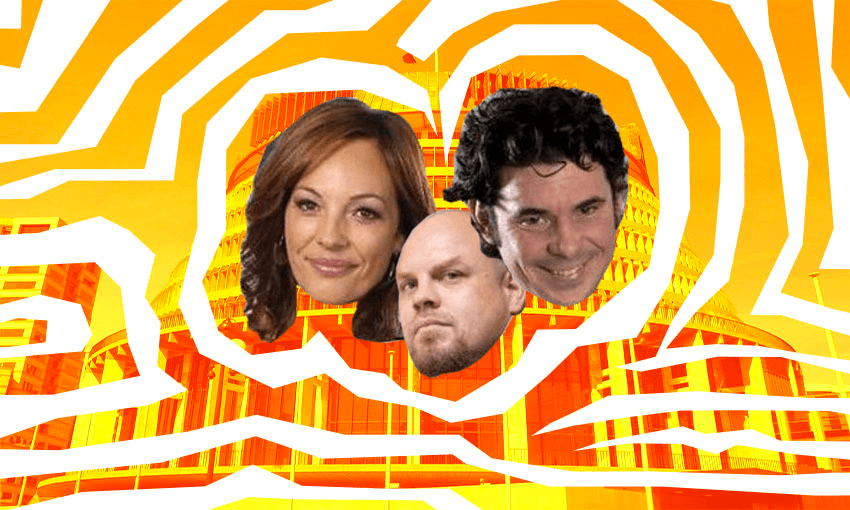Alex Casey suggests a bold amendment to the social media ban.
Last week, National MP Catherine Wedd chucked a member’s bill into the biscuit tin that would restrict social media access for anyone under the age of 16. Following a world-first crack down in Australia, the Social Media Age-Appropriate Users Bill would take “all reasonable steps” to prevent those under 16 years old from accessing social media, with the aim of “protecting young people from bullying, inappropriate content and social media addiction”, said Wedd.
The bill unleashed a flurry of reactions, with David Seymour describing it as a “ridiculously simple” solution while Chris Hipkins was “broadly supportive” but called for a more detailed government-led bill. Then on Sunday, Luxon announced that social media restrictions for under-16s will become part of the government’s official work programme, with education minister Erica Stanford tasked to “explore options” for cabinet to consider in the future.
So while we are spitballing our options, here’s a bold consideration from an Age-Appropriate User: why stop at 16? Why not also ban the over 65s, more likely to be in exposed to misinformation and subjected to social media scams? Why not also ban former reality TV stars for sharing weird AI videos? Why not the late teens chasing UV on TikTok? And, most crucially, why not ban me, throw my phone in the biscuit tin and submerge it in piping hot school lunch magma?
I saw a thing on Instagram the other day – couldn’t tell you who posted it, or if it was a cartoon or an X screenshot – that said something along the lines of “I’m sorry for viewing your Instagram story within the first 15 seconds, but you have to understand that I haven’t put my phone down for six years.” It’s a sentiment that cracked me up but also cut deep: I’ve tried almost everything apart from my Users Device Trapped In Biscuit Tin Magma Bill to curb my addiction.
In 2021, I deleted Twitter after staring at the Capitol riots for what felt like four days straight (they lasted four hours). I immediately emailed Twitter HQ and pleaded with them to reinstate it. Instagram followed soon after. “I started giving up hours of my own weekend to lie on the couch and watch other people’s weekends,” I wrote in a chin strokey op ed in 2023, high on my own social media free supply and unaware that I would be back in less than a year.
I’ve tried all the different apps and tricks like turning the screen black and white, all to no avail. I even bought an old Nokia brick phone from a deceased estate on Trade Me, which was all going well until I turned it on and found heaps of scary pixelated photos of old feet in slippers. Last year I embraced the brick once more for a sublime 48-hour smartphone-free challenge in Melbourne, and felt a sense of peace and calm inside my brain I hadn’t felt in years.
There are plenty of other non-teenagers out there like me who also harbour this kind of sad, silent, social media addiction. A 2021 study found that 36% of New Zealanders considered themselves addicted to their screens, spending over five hours a day in front of screens outside of work or education. Half of the people surveyed (52%) reckoned it negatively impacted their physical health, and more than one-third (37%) said it was bad for their mental health.
What these numbers don’t go into is how insidiously it seeps in and disrupts your everyday life, until one day you’re ignoring entire plotlines in TV shows, missing crucial details in IRL conversations, nipping away from social events to go to the toilet and get a quick hit of… a Shortland Street actor unboxing a toastie machine? An AI video of Rose vlogging the sinking of the Titanic? An influencer getting what looks like half a cup of golden syrup sucked out of her face?
In our house, we colloquially refer to the worst of it as a K Hole, a nod to the hallucinatory and dissociative state that sees total detachment from one’s body and environment due to the overconsumption of ketamine. But my drug isn’t ketamine, it is lip-reading deep dives of Blake Lively on the red carpet, this compelling reel about an egg yolk and an army of matches, and frenzied thrift hauls from mid-western mums with sock curls on the other side of the world.
“Are you in a K-hole again?” my husband will holler into the dark abyss of my office every night, 20 minutes after I furtively muttered “I’ll just go put my phone on charge”. Soon he will find me, paying homage to the guy at the end of Blair Witch Project by facing the corner in the total darkness, head bowed, indeed in a K Hole. Mornings aren’t much better either – not when I’m staggering out of the loo with the creaking gait of the Tin Man due to once again sitting on my phone for too long.
It’s humiliating to admit all of this, but also important to remember that this behaviour isn’t normal in anyone, of any age. Terms like “brain rot” and “doom scrolling” have become so commonplace that their catastrophic connotations of death and decay barely register anymore. We need more severe language and stricter measures for people like me, who spent over 13 hours on Instagram last week. That’s an entire weekend of every month, 700 hours per year, or a solid month of scrolling.
Ban the kids, sure, but then please ban me too.




